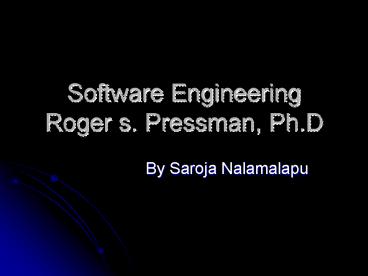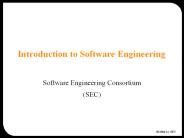Software Engineering Roger s' Pressman, Ph'D - PowerPoint PPT Presentation
1 / 25
Title:
Software Engineering Roger s' Pressman, Ph'D
Description:
In software problem analysis- design and testing slowly evolved.And at the same ... The Landscape. Different methods to achieve activities: ... – PowerPoint PPT presentation
Number of Views:8230
Avg rating:5.0/5.0
Title: Software Engineering Roger s' Pressman, Ph'D
1
Software EngineeringRoger s. Pressman, Ph.D
- By Saroja Nalamalapu
2
Software Engineering
- 1. Layered Technology
- 2. Process Models
- 3. The Management Spectrum
- 4. Software project Management
3
5.Software Quality Assurance
- SQA Conformance to explicitly stated functional
and performance requirements, explicitly
documented development standards, and implicit
characteristics that are expected of all
professionally developed software.
4
factors
- McCall and Cavano defined a set of quality
factors that were a first step towards the
development of metrics for software quality.
These factors assessed software from 3 distinct
point of views (1) product operation (using it)
(2) product revision (changing it) (3) product
transition (modifying it to work in a different
environment, i.e. porting)
5
factors
- These factors include correctness, Reliability,
Efficiency, Integrity, Usability,
Maintainability, Flexibility, Testability,
Portability, Reusability, Interoperability . - Invariant in past 20 years.
6
Specification and design
- SQA begins with a set of technical methods and
tools that help the analyst to achieve a high
quality specification and the designer to develop
a high quality design. - Formal technical review to accomplish quality
assurance. - FTR-walk through or an inspection.
7
Software testing
- Combines multi-step strategy with a series of
test case design methods that help ensure
effective error detection. - Even testing is not effective. So use FTRs
- The major threat to software quality comes from
changes. - Measurement Software metrics must be colleced.
8
6. Software Configuration Management
- The art of coordinating software development to
minimize.. Confusion - It is an art of identifying, organizing and
controlling modifications - Goal Maximize productivity
- SCM activities are developed to 1)Identify the
change 2)control change 3)ensure that the
change is implemented 4)report change to others
9
7.The Technical Spectrum
- In software problem analysis- design and testing
slowly evolved.And at the same time to make the
software engineering tasks more systematic,
methods were developed. - Some methods stood the test of time.
10
Software Engineering methods-The Landscape
- Different methods to achieve activities
- 3 different regions ---Conventional software
engineering methods, Object oriented approaches,
formal methods. - Single objective to create high quality SW
- Any method, if properly applied within a context
of a solid set of sw engineering principles, will
lead to higher quality sw than an undisciplined
approach.
11
Problem Definition
- Customer communication
- Basic requirements, then req. analysis.
- Analysis Principles
- 1.The data domain of problem must be modeled
(data objects) - 2.The functional domain of the problem must be
modeled (modeled as hierarchy, services to
classes within the system, or a set of
mathematical expressions.
12
Analysis Principles cont.
- 3. The behavior of the system must be
represented (externally observable states of
operations and how transform occurs) - 4. Models of data, function and behavior must be
partitioned (As the problem definition
progresses, detail is refined and abstraction is
reduced partitioning) - 5. The overriding trend in analysis is from
essence toward implementation (Implementation
leads from analysis toward design)
13
Analysis Methods
- Beyond the scope
- Similarities among different methods and regions
data objects and relationships, - how functions operate on data, behavior at
system level at more localized level,
partitioning approach that leads to more
detailed, foundation at which design begins
14
Design
- Set of basic principles and a pyramid of modeling
methods that provide the necessary framework for
getting it right - Design principles1. Data and the algorithms that
manipulate data should be created as set of
interrelated abstractions. - 2.The internal design detail of data structures
and algorithms should be hidden from other sw
components
15
Design principles cont.
- 3. Models should exhibit independence
Effective modularity, i.e. independent models are
easier to develop - 4. Algorithms should be designed using a
constrained set of logical constructs
Structured programming
16
Design Pyramid
- Data design translates the data model created
during the analysis into DS - Architectural design differs in intent depending
upon the designers view point - Conventional design creates hierarchical sw
architectures - OOD views architecture as message network that
enables objects to communicate
17
Design Pyramid cont.
- Interface design creates implementation models
for human- computer interface - Procedural design is conducted as algorithms are
created to implement the processing requirements
of program components
18
Program construction
- 4th generation techniques, graphical programming
methods, component-based sw construction - The challenges that face can only be solved
through better approaches to analysis and design
, more comprehensive SQA techniques, more
effective and efficient testing
19
Software Testing
- Testing is the process of executing a program
with the intent of finding an error - Good test case high probability of finding an
as-yet-discovered error - Successful test uncovers an as-yet-discovered
error - Testing can not show the absence of defects, it
can only show that the sw defects are present
20
Strategy
- Characteristics of SW testing strategies
- 1) Testing begins at module level
- 2) Different testing techniques are required
at different points of time - 3) Testing is conducted by developer of SW and
an independent test group - 4) Testing and debugging are different
activities.
21
Tactics
- Any engineered product can be tested in 2 ways
- 1)knowing the specified function that a product
has been designed to perform (Black-box testing)
- 2) knowing the internal workings of the product
(white-box testing)
22
Reuse
- To build faster software
- Components must be demonstrably defect free
23
Reengineering
- SW plant must be rebuilt and that demands a
reengineering strategy - Takes time and money
- Paradigm for reengineering inventory analysis,
document restructuring, code restructuring, data
restructuring, reverse engineering (examine
software internals to determine how the system
has been constructed), forward engineering (
rebuild the applications with modern SW pracices
and principles)
24
Retooling
- New generation of SW tools to meet the
expectations - They should emphasize Reuse and Reengineering
25
Thank you.









![[CS-225: Software Engineering] PowerPoint PPT Presentation](https://s3.amazonaws.com/images.powershow.com/7552154.th0.jpg?_=20160119103)





















